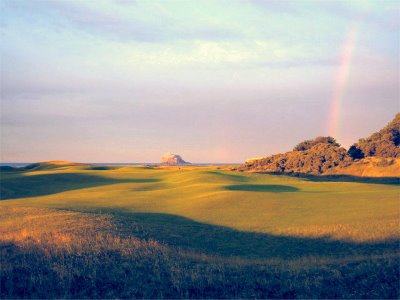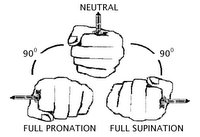
I flew to Chicago for this?
The Club and ClubhouseMedinah Country Club (ranked #52 in the world) is located in suburban Chicago. Medinah is a private member owned country club which has three golf courses featuring 640 acres of property and 18,000 trees. Medinah was founded in 1925 by the Shriners, who thought it would be interesting to build a clubhouse with an unusual style of architecture. The clubhouse is certainly one of the most unique in the world of golf at 60,000 square feet. It has an eclectic style evocative of the near east and contains elements of many architectural styles including Italian, Oriental, Louis XIV and Eastern. The club was named after the holy city of Islam in Saudi Arabia by the same name. Medinah is the second holiest city in Islam after Mecca and is famous for the presence of the shrine of Mohammad, known as the Green Dome, thus the likeness to the Medinah clubhouse. Like Mecca, Medinah permits only Muslins to enter. You can enter Medinah Country Club, however, if you are the guest of a member.
I am always excited about finally being able to play courses that have hosted major championships and that I have seen on TV. The clubhouse at Medinah displays its history to very good affect with memorabilia from Tiger's victories and many other historic pictures and collectables. The interior of the clubhouse is striking and it does impress, as you can see below.
 Under the Green Dome
Under the Green Dome
 The Entry Foyer
The Entry FoyerAt 60,000 square feet, it has room for everything. The pictures below were taken in the ball room of the clubhouse that is quite grand; it even has a stage for performances.

I especially like the architectural detailing of the pilasters in the ball room seen above and below.
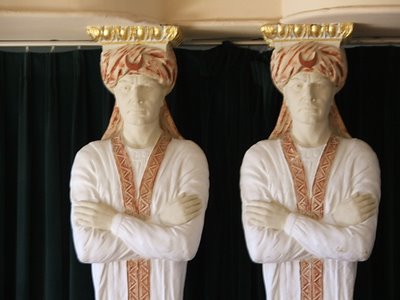 History of A Championship Course
History of A Championship CourseAll three courses at Medinah were designed by Tom Bendelow. The course has hosted the US Open three times (1949, 1975 and 1990), the PGA twice (1999 and 2006, both won by Tiger Woods) and will play host to the Ryder Cup in 2012. The #3 championship course is one of the longest in championship golf at 7,500+ yards. One of the key features of the course is the man-made Lake Kadijah that comes into play several times, including early in the round on the second hole, seen below.
 The par three second hole
The par three second hole
I can see why Medinah hosts major championships. The world's best players like to bomb the ball and Medinah definitely has length. In addition, the greens are fast. There is plenty of room for tents, parking, concession stands, etc. The clubhouse, locker room and practice facilities are all world class and it is close to a major airport, actually quite close to one of the biggest in the world - O'Hare.
Holy Shit!Unfortunately, hosting a big tournament and a great golf course are two separate and unique things. Medinah is not a great golf course and is completely overrated. It suffers from the same thing Wentworth does - it's a great course to host a professional tournament - it can handle large crowds, etc., but the course has no personality and requires no imagination to play it. I am not taking anything away from the club and the PGA and USGA for hosting tournaments there; no doubt it's a great choice for what they are trying to achieve. The problem is, the course is weak. Certainly long, but weak when compared to the world's other great courses.
I found the par threes to be BORING. Holes 2, 13 and 17 are almost identical par threes. All require you to hit a tee shot over the man-made lake to an uninteresting green. By the time you get to the 17th tee you think to yourself, "This looks familiar." Actually, it is familiar since you've played near identical holes at #2 and #13. These are the signature holes?
The 10th hole is the least idyllic hole I have ever played in my life. At Maidstone you experience the Atlantic Ocean lapping along the sands. At Casa de Campo, the waves crash around you. At Crystal Downs you have the beautiful view of the countryside and lake below. At Medinah, you get the noise of US-20, which runs down the entire left side of the hole. The lovely tee box is shown below.
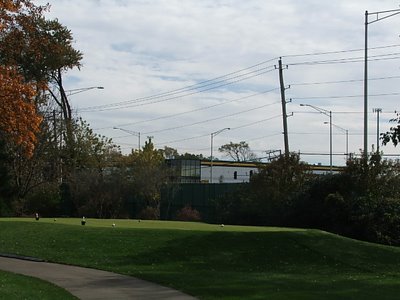
While playing this hole, it was so loud I couldn't even hear my playing partner when he spoke. The same din from the highway is present on the 15th green and 16th tee. The hole is actually a pretty good par five; you just can't appreciate it with all the noise.
Like Wentworth, the other issue I found at Medinah is that there are a lot of jets flying over head. It is apparently directly over a landing pattern for O'Hare. O'Hare has parallel runways and often times you will see not one, but two low-flying jets. Sometimes, planes can be charming when near a golf course. I have played both the Old Course at St. Andrews and Royal Dornoch with the sounds of RAF jets taking off and landing and found it actually added to the ambiance. At the Moray Golf Club in Scotland, a runway from RAF Lossiemouth. It is at the end of one of the fairways. I found it exhilirating to have a fighter jet take off occasionally. I didn't find that here, probably because a plane flew overhead about every 30 seconds all day. I took the picture below from the 12th fairway. Notice the landing gear down and the passengers waving to us below.

I found the course to be shitty the day I played. Not shitty in the figurative sense. Shitty in the literal sense. To be precise, shit from Canadian geese was everywhere. I'm sure there are times when the course is in immaculate condition. Unfortunately, I was not there during one of them. I'm sure I will be accused of being unfair, but I can only call it by what I see firsthand. If you will allow me the liberty to repeat myself for emphasis: There were turds on every tee box, there was feces in the fairways and there was poop on the putting greens. Lest I be accused of making this up, through the wonders of my digital camera I present as exhibit 'A' the 8th green seen below.
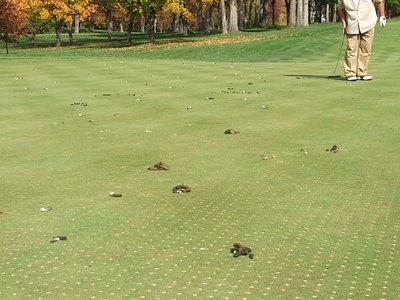
Why doesn't the course invest in some border collies and be done with the geese? We played this green at about 1:00pm, so there was plenty of time for the greenskeeping staff to clear it off. Perhaps they were pre-occupied with the squirrels. Several of the greens had fairly significant holes in them, apparently from squirrels who thought they would be a good place to bury acorns. I kid you not.
While I am not a golf course architect, I can sum up what's wrong with the course with an analysis of the 15th hole. A 392 yard par four, it has a large stand of trees on the left side of the fairway, some of which overhang, making an approach shot from the left side of the hole difficult. The bunkers were also put on the left side, under the trees, leaving the entire right side of the hole open, with no hazards. A drive to the right leaves a clear shot to the slightly elevated green. It doesn't take a genius to see that this is not brilliant design. It would probably have been better to put the bunkers on the right side of the fairway to cause the golfer to hit the ball left and thus have a more restricted shot at the green. Or to require a precise shot in the middle of the fairway. All you have to do is aim right and you're fine. My point is, when a layman notices stuff like that, it's probably not a sign of brilliance in architecture.
In the interest of fairness, the trees at Medinah are beautiful, and they do create a park-like effect overall. I found the 12th hole interesting; it has a big slope from the left side of the fairway to the right side the entire length of the hole as you can see if you look at the cart riding toward the green. The picture was taken from the green looking back.
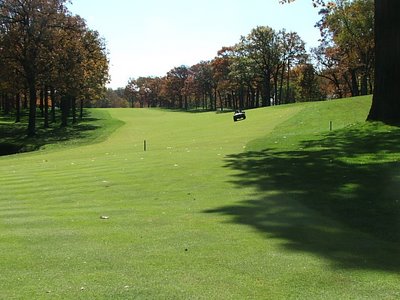
The 14th is an interesting par four with good use of the hilly terrain and a challenging shot to an elevated green. The 16th and 18th aren't bad and again are routed in an interesting fashion as are some of the elevated greens on the course, as pictured below.
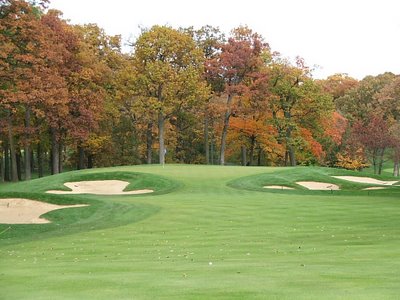
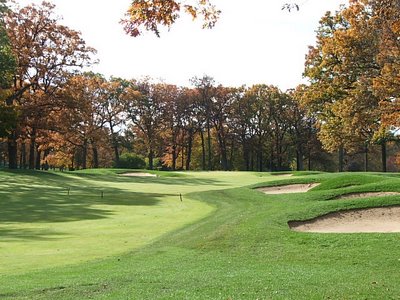
As you've probably guessed by now, I didn't like Medinah. I was actually so taken aback after playing that I actually had to double check that I indeed had played the championship course - #3, since Medinah has multiple courses.
Indeed, I had.
To make my day even more special, we were paired up with a "gentleman" who had gotten on the course as an unaccompanied guest through "a friend of a friend of a friend," as he put it. The "sausage king of Chicago", he was a local purveyor of fine meats stuffed in animal intestines. He did a perfectly good impression of Tony Soprano on the golf course. He rode in a cart, although he could certainly have used the exercise. He had a cell phone strapped to his belt and would occasionally talk into it walkie-talkie style to provide color commentary to his friends "Joey, I'm on the 14th tee at Medinah, you know what I mean?" He wore a button down shirt with the first six (of seven) buttons un-buttoned so you could see his lovely white tee shirt. And the shirt was intentionally not tucked in all day. Call me a snob if you like, but this pretty much sums up everything in golf I don't like in a playing partner. Thank goodness, at least he played fast.
If you go to play Medinah I suggest doing so during baseball season. Go to Wrigley Field and see a Cubs game so the trip won't be a total disappointment.
And be sure to scrub your hands very good after playing to remove all the fecal matter.
 Unfortunately, I witnessed the defeat in person as my team came into town to face the nation's #3 BCS team. It was a huge loss because it knocked us out of the coveted Rose Bowl.
Unfortunately, I witnessed the defeat in person as my team came into town to face the nation's #3 BCS team. It was a huge loss because it knocked us out of the coveted Rose Bowl.


